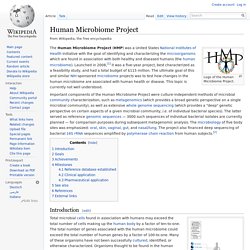

Human Microbiome Project reveals largest microbial map. 13 June 2012Last updated at 14:22 ET By Smitha Mundasad BBC News Researchers sampled five areas of the bodies of healthy volunteers "When I get up from my chair, ten times more bacterial cells get up than human ones," says Dr Bruce Birren.

He is one of the hundreds of US scientists involved in the world's most extensive map of the microbes that live in and on us. The Human Microbiome Project has catalogued the genetic identity of many bacteria, viruses and other organisms that live in intimate contact with us. They are not germs that need eliminating but a fundamental part of what makes us human, researchers say. Human Microbiome Project. Microbe census maps out human body's bacteria, viruses, other bugs - Page 2. At left, an image from the National Institute of Allergy and Infectious… (Associated Press ) After five years of toil, a consortium of several hundred U.S. researchers has released a detailed census of the myriad bacteria, yeasts, viruses and amoebas that live, eat, excrete, reproduce and die in or on us.

Described in two papers in Nature and a raft of reports in other journals, the data released Wednesday describe microbes of the skin, saliva, nostrils, guts and other areas of 242 adults in tiptop health. The $170-million, federally funded Human Microbiome Project also cataloged the genes contained within this zoo of life. The results shed light on the hum of microbial activity inside us as nutrients are chopped and guzzled, gas and other wastes are expelled, and bugs send chemical messages to one another, jostling for supremacy or attracting new neighbors to help keep their community going.
First, they probed each sample for a key gene contained in all bacteria. Human Microbiome Project. Logo of the Human Microbiome Project.

The Human Microbiome Project (HMP) was a United States National Institutes of Health initiative with the goal of identifying and characterizing the microorganisms which are found in association with both healthy and diseased humans (the human microbiome). Launched in 2008,[1] it was a five-year project, best characterized as a feasibility study, and had a total budget of $115 million. The ultimate goal of this and similar NIH-sponsored microbiome projects was to test how changes in the human microbiome are associated with human health or disease. This topic is currently not well understood.